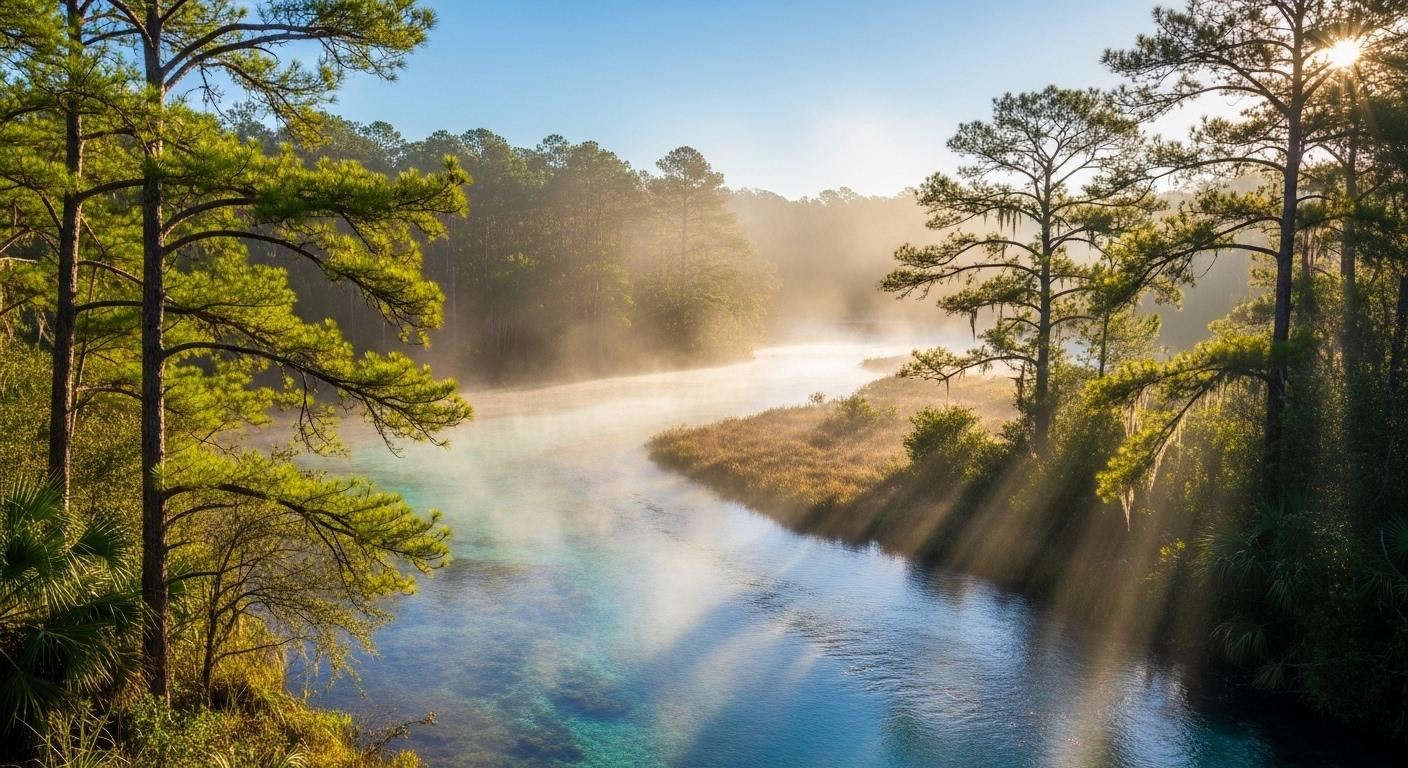At 6:47 AM, golden light filters through longleaf pines onto the crystal-clear turquoise water of Juniper Springs. A river otter surfaces 10 feet away, oblivious to your presence. Your canoe rental cost $34. The resort beach town you passed charged $400 per night. This is Florida’s oldest national forest, where 1.1 million annual visitors discover what coastal crowds miss: 607 square miles of spring-fed rivers, ancient pine forests, and wildlife encounters accessible for less than a dinner at tourist restaurants.
The 6:47 AM window when springs reveal their secret
Morning arrival at Juniper Springs before day crowds offers something money can’t buy: silence. The 72°F spring water emerges from limestone at 13 million gallons daily, creating clarity that lets you see 30 feet down.
Mist rises from the water surface. Ospreys and herons awaken with soft calls echoing through the canopy. The moment when light first touches the water creates shifting patterns of turquoise and gold that no resort pool can replicate.
Visitors arriving at 11 AM face parking challenges and crowd noise. The forest spans central Florida, 70 miles from Orlando, preserving Marion County’s pine flatwoods and sand scrub ecosystems unchanged since its 1908 establishment as America’s oldest national forest east of the Mississippi River.
What $34 buys you that beach resorts can’t replicate
Crystal springs that rival any resort pool
Juniper Springs Run offers a 7-mile paddling journey through twisting channels too narrow for motorboats. Water maintains constant 72°F year-round while visibility rivals Caribbean snorkeling spots.
Alexander Springs provides a 76°F swimming area with white sand bottom spanning 2.5 acres. Silver Springs’ glass-bottom boat tours reveal underwater caves and springs fed by the 13 million-year-old Floridan Aquifer system.
Wildlife encounters money can’t guarantee
River otters appear at 70% probability during morning hours at Juniper Springs Run. Alligators maintain safe distances of 15 feet or more, with no serious incidents reported in five years according to Forest Service records.
White-tailed deer emerge at dawn while wild turkeys and rare fox squirrels inhabit over 600 lakes and ponds. This habitat diversity supports 200+ bird species, with fall migration bringing peak wildlife viewing opportunities. The limestone formation creates perfect spring conditions that controlled wildlife experiences at commercial attractions charging $75+ admission simply cannot match.
The activities locals return for (all under $40)
Water adventures from paddling to swimming
Juniper Springs Run canoe rental costs $34 including shuttle service back to the starting point. Rainbow River tubing runs $24-30 per person while Alexander Springs swimming requires only a $5 day pass.
Best seasons span October-November and March-May for comfortable temperatures ranging 60-80°F with fewer mosquitoes. Early morning advantages include optimal wildlife viewing and guaranteed parking availability at popular springs.
Campground rates of $20-36 per night compare favorably to coastal resort rooms at $400+. Day hiking trails wind through longleaf pine and sand pine scrub while the new 2025 eco-visitor center at Juniper Springs offers educational exhibits.
Forest trails and local flavors
Fishing in 600+ lakes requires a Florida license costing $17.50 for three days. Birding opportunities include ospreys, herons, and sandhill cranes throughout 388,000 protected acres.
Fresh local cuisine in nearby Ocala features fried catfish, stone crab, and citrus specialties at $10-15 per meal. Recent visitor surveys consistently rate the authentic wilderness experience higher than commercialized beach destinations while spending 60-75% less on accommodations and activities.
Why forest service manages what developers wanted
The 1908 establishment protected these springs during Florida’s first development boom. While coastal areas transformed into resort corridors, the Forest Service maintained wilderness integrity across central Florida’s interior.
Today’s contrast remains stark: Everglades draws international crowds requiring boat access while Ocala preserves solitude accessible by car. A local paddle guide with decades of river experience notes how the water’s clarity creates timelessness.
The forest protects what commercialization destroys: silence broken only by wildlife, dawn light on untouched water, and the profound calm of unhurried nature. Federal wilderness designation now protects 85,000 acres within Florida’s national forests from the development pressure that consumed nearly all coastal natural areas.
Your questions about Ocala National Forest, Florida: River adventures & wildlife encounters answered
When should I visit to avoid crowds and heat?
Late October through November offers 58-82°F temperatures with minimal mosquitoes and 40% fewer visitors than spring break periods. Winter months of December-February provide 50-70°F weather ideal for hiking without swimming crowds.
Summer brings 75-95°F heat and humidity but perfect spring swimming conditions. Arrive before 9 AM to secure parking at popular Juniper Springs during peak season.
What makes Ocala’s springs different from other Florida destinations?
Constant 72°F water temperature year-round from the limestone aquifer system creates Caribbean-quality clarity with 30+ foot visibility. Protected forest setting prevents commercial development from encroaching on spring basins.
Moderate visitor numbers of 1.1 million annually contrast favorably with Everglades’ overwhelming international tourism or beach towns’ 20+ million crowds while maintaining authentic wilderness character.
How do costs compare to typical Florida beach vacations?
Ocala camping runs $20-36 per night versus beach resort rates of $400+ nightly. Canoe rental costs $34 compared to jet ski rental at $150+ per day.
Restaurant meals average $10-15 versus beachfront dining at $50+. Total daily budget ranges $100-150 for families compared to $600+ at coastal destinations, providing 60-75% savings while gaining authentic wilderness access and guaranteed wildlife encounters in America’s oldest national forest east of the Mississippi.
Dawn breaks differently in ancient forests. At Juniper Springs, an otter disappears into crystal water while your coffee steams in 62°F October air. The coastal resorts wake to alarm clocks and breakfast buffet lines. Here, $34 bought access to what 117 years of protection preserved: Florida as it was, as it should remain.
